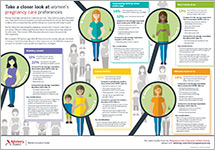Auto logout in seconds.
Continue LogoutHospitals around the country are testing out virtual reality (VR) headsets as a way to reduce women's pain during labor, and early research suggests the technology might be effective, Andrea Peterson reports for the Wall Street Journal.
Webconference today at 3 pm ET: Women's health market trends for 2019
Why more hospitals are testing VR
Melissa Wong, a fellow in maternal-fetal medicine at Cedars-Sinai in Los Angeles who is currently leading a study of VR in labor, explained, "Women are interested in having other ways they can help cope with contractions during labor." She added that the VR headsets may help women "have some degree of control in an otherwise difficult-to-control" situation.
For example, researchers at several hospitals are looking at whether VR can help women in the early part of labor, when pain isn't as intense. Wong noted that VR might help women avoid an early epidural—which some studies have tied to longer labors and higher risk of caesarean section. Researchers at Stanford University School of Medicine are also exploring whether VR could be used while a patient is receiving an epidural.
That said, researchers don't view VR as a complete replacement for intravenous medication and epidurals, Peterson reports, but rather as another tool in the arsenal.
How VR during labor works
At Cedars Sinai, and other hospitals, VR content for childbirth is specifically designed to refocus women's attention during labor and delivery by including breathing and mindfulness exercises as well as supportive language from a "virtual doula, or birth coach," according to Wong.
And that was the case for Aviva Lahmany, who took part in the Cedars-Sinai VR study eight months ago during her labor. Lahmany had asked for an early epidural to ease the pain, but hospital staff advised her to wait and try VR.
"The pain was really bad," Lahmany said. "At that point, I was willing to do anything."
When Lahmany put on the headset and goggles she saw a blooming tree and a woman's voice instructed her to match her breathing with the movement of its leaves and branches. In the next scene, Lahmany saw waves crashing on the beach. The 30-minute session "takes you out of that hospital room," Lahamany said. And the result was positive, her pain fell from a seven to a three on a 10-point scale, and allowed her labor to progress further before receiving the epidural.
"I was able to actually breathe," Lahamany said. "It really helped center me and calm me."
Early data suggest VR could ease early labor pain
Research shows Lahmany isn't the only patient to experience effects like this.
In a recent study published in Anesthesia & Analgesia in July, researchers found a 10-minute VR session during early labor helped reduce participants' worst pain intensity by 21% participants' time spent thinking about the pain by 43%. Women's scores of how unpleasant the pain was dropped by 34% with VR compared with those who did not use the technology.
In addition, Banner Health recently completed an unpublished trial on the benefits of VR during early labor and found that patients who used VR were 50% less likely to use IV pain medication Stadol than the patients who didn't use VR.
While researchers have yet to determine how VR alleviates pain and anxiety, scientists said that the immersive nature of VR might distract patients from their pain, Petersen reports
Is VR coming to a delivery room near you?
More hospitals are likely to employ VR in delivery rooms in the future, especially as VR becomes more widespread and the equipment becomes more affordable, Petersen reports.
But Petersen writes that there can be "hurdles" to using VR during labor and delivery. For one, VR can cause nausea, which is undesirable for pregnant women who are already prone to nausea. Additionally, VR isn't practical to use for extended periods of time, and labor can sometimes last days.
Despite the negatives, one of the "selling points" of VR is that it gives patients control, as well as the chance to change their minds, Petersen writes. "If it bothers you, you can take [the goggles] off," said Michael Foley, chair of the department of obstetrics and gynecology at Banner-University Medical Center (Petersen, Wall Street Journal, 2/6).
Webconference today at 3 pm ET: Women's health market trends for 2019
Women’s services face shifting demographics, including an aging and increasingly chronic, multi-morbid population and declining birth rates, that will continue to impact the demand for services. This webconference addresses those challenges and also offers insights on the women’s service line's financial outlook, and other major trends.
Don't miss out on the latest Advisory Board insights
Create your free account to access 1 resource, including the latest research and webinars.
Want access without creating an account?
You have 1 free members-only resource remaining this month.
1 free members-only resources remaining
1 free members-only resources remaining
You've reached your limit of free insights
Become a member to access all of Advisory Board's resources, events, and experts
Never miss out on the latest innovative health care content tailored to you.
Benefits include:
You've reached your limit of free insights
Become a member to access all of Advisory Board's resources, events, and experts
Never miss out on the latest innovative health care content tailored to you.
Benefits include:
This content is available through your Curated Research partnership with Advisory Board. Click on ‘view this resource’ to read the full piece
Email ask@advisory.com to learn more
Click on ‘Become a Member’ to learn about the benefits of a Full-Access partnership with Advisory Board
Never miss out on the latest innovative health care content tailored to you.
Benefits Include:
This is for members only. Learn more.
Click on ‘Become a Member’ to learn about the benefits of a Full-Access partnership with Advisory Board
Never miss out on the latest innovative health care content tailored to you.

